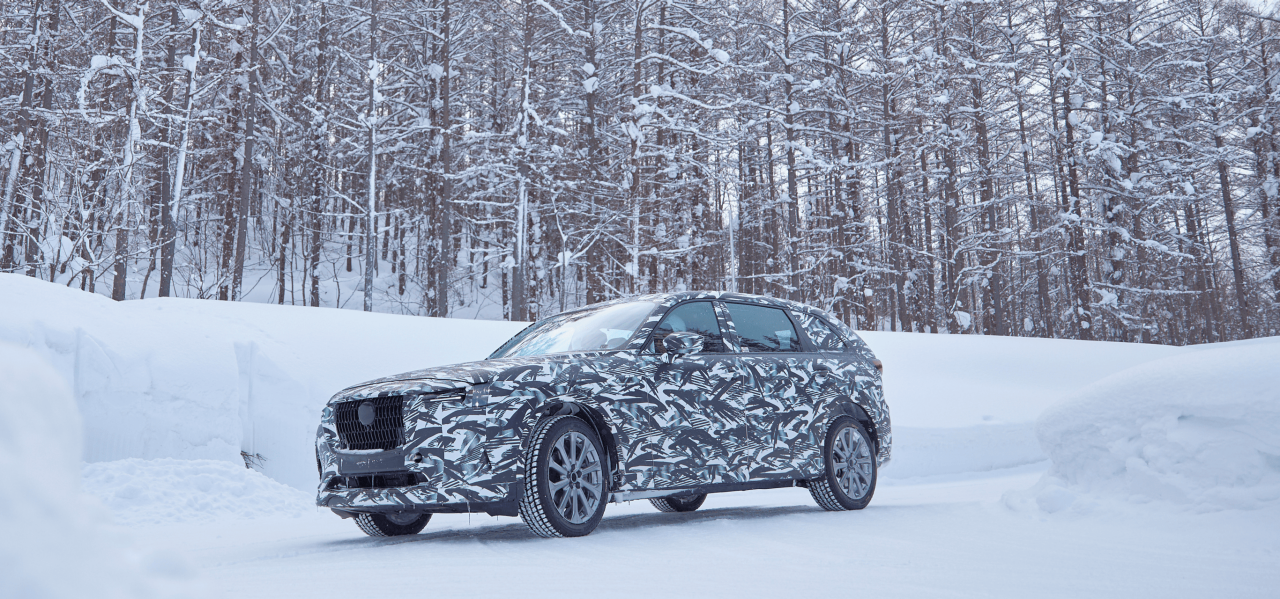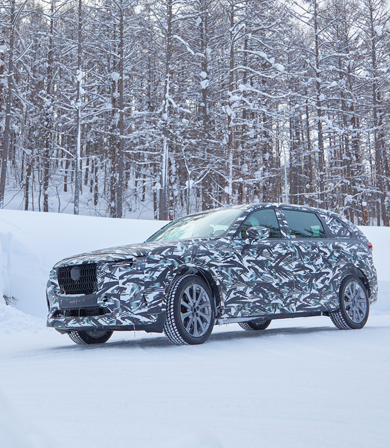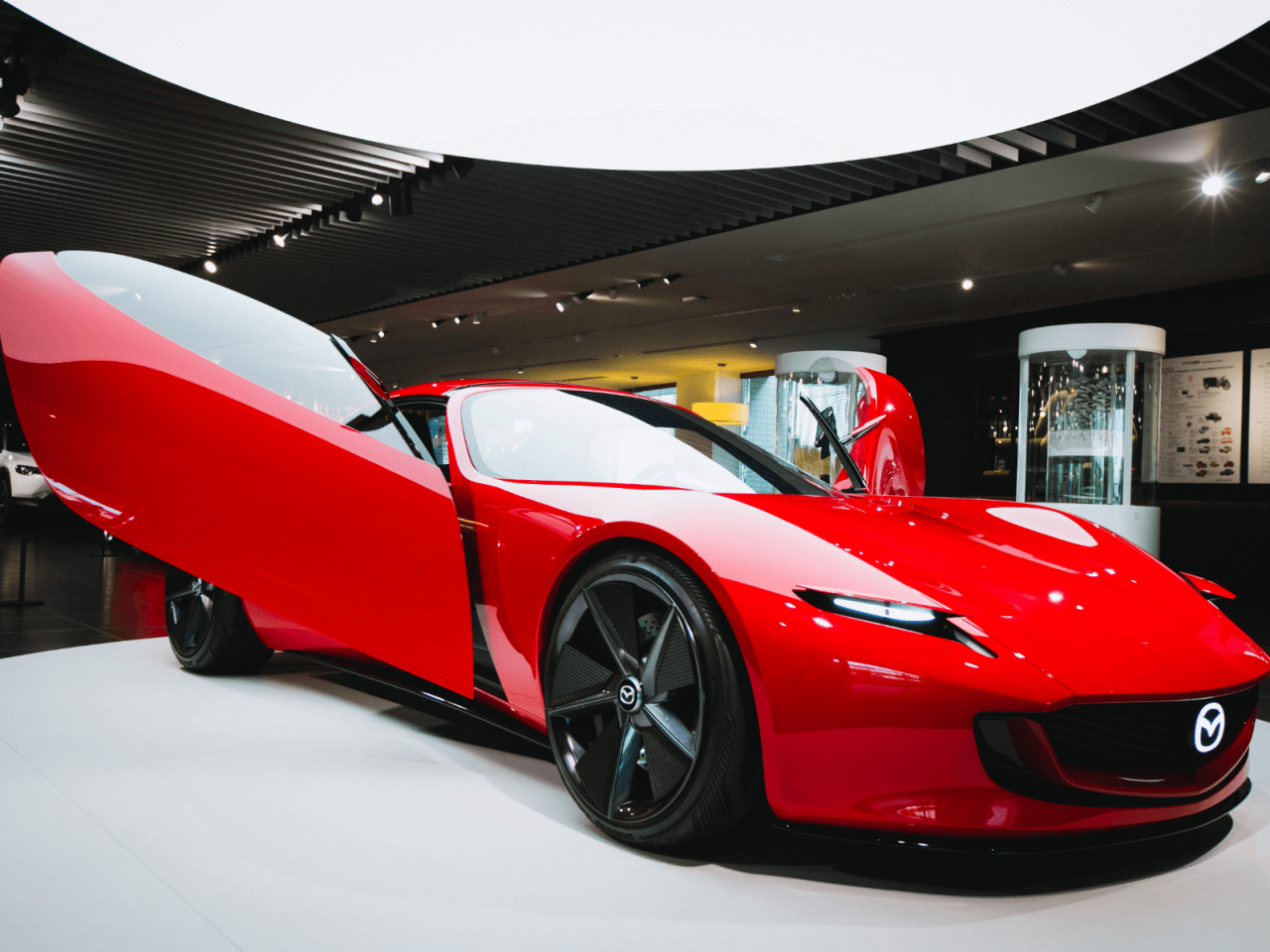2025.02.07
The -25°C Proving Ground that Honed the CX-80: Testing on Untamed Winter Roads Shaped by Community
Deep in the winter forest, a lone car with distinctive custom camouflage decals, speeds along a snow-covered road.
This is the Mazda CX-80, launched in October 2024.In early 2024, before the car's release, it underwent snow performance testing at Mazda's Kenbuchi Proving Ground: an extreme cold weather testing site where temperatures regularly plummet below -25°C.
Here, cars aren’t “developed,” they’re “honed” by the harsh climate. It's a sentiment echoed by the local townspeople, who take pride in how their unforgiving terrain hones the car. This is a story of dedication—of passionate engineers quietly perfecting their craft in relative obscurity, and of the deep connection that has grown between Mazda and the local community.








Kenbuchi: A World of Winters in One Town






When we heard the CX-80 was undergoing winter testing in early 2024, the Mazda Mirai Base editorial team headed to Hokkaido.
About an hour's drive north of Asahikawa Airport lies the town of Kenbuchi. This area of Hokkaido's Kamikawa region has earned a unique distinction: it's home to one of Japan's largest concentrations of automotive testing grounds. Not just Mazda, but many major Japanese automakers have established facilities here.
Yet, when snow blankets much of northern Japan in winter, what makes this area so special? The answer lies in the quality of the snow itself, explains Yoshiatsu Kuga, Head of Vehicle Proving Ground, a part of the Vehicle Development Division.


Yoshiatsu Kuga, Head of Vehicle Proving Ground, Vehicle Development Division.
“Mazda cars are made in Japan and shipped to drivers across the world,” explains Kuga. “This means they could be driven in any environment imaginable. It’s our job to make sure that no matter where our customers drive, they can do it safely and with peace of mind.
That's what makes Kenbuchi's snow so perfect for testing. In midwinter, we get powder snow similar to what you'd find on Canadian roads. As it warms up a little, it becomes the wet, packed snow typical of Europe and northern Japan. Essentially, we can recreate most of the world's winter driving conditions in this one location. And with temperatures dropping below -25°C, it's ideal for honing the car.”
Why Hiroshima Can’t Match the Real-World Honing Power of Kenbuchi Proving Ground
The Kenbuchi Proving Ground enables testing in environments that simulate different snow conditions around the world. Here, cars undergo rigorous testing of their basic functions: accelerating, turning, and stopping.
But there’s something in the air at Kenbuchi, a palpable tension that’s different to other Mazda testing facilities.We spoke with Masahiro Niwa, a brake system engineer conducting winter testing at Kenbuchi to learn more.
Masahiro Niwa, Vehicle Dynamics Function Development Group No.1, Chassis Dynamics Development Department, Vehicle Development Division.


Masahiro Niwa, Vehicle Dynamics Function Development Group No.1, Chassis Dynamics Development Department, Vehicle Development Division.
“I’m usually based at Hiroshima, but for two months each winter, I work at Kenbuchi,” says Niwa. “At the Hiroshima lab, we have the capability to simulate snow and cold temperatures, but when it comes to replicating real-world driving conditions, nothing beats nature itself.
At Kenbuchi, we can see exactly how snow and ice affect brake performance under conditions that closely match what our customers will experience. Will the brakes lose effectiveness? Could they fail? These are the questions we need to answer.
We test under every possible scenario to enhance performance. Working with nature means dealing with constantly changing conditions—from blizzards one day to clear skies the next. We hone our vehicles in this environment to be confident they can handle it all safely and reliably, whether it's powder snow, melting slush, packed snow, or sheer ice.
Every morning starts with a careful study of the weather forecast. We have to make the most of every testing opportunity during these limited winter months, so we're out there putting the vehicles to the test no matter what nature throws at us.”






Niwa continues. “In my work with brakes, my ultimate goal is to go unnoticed. When a driver brakes with normal pressure, they should get a normal braking response.
That might sound simple, but making it happen consistently in any environment requires exhaustive testing across global conditions. That’s why we keep refining our vehicles until they can achieve this ‘normal' braking performance in every condition. We don't want drivers to feel they need to brake differently because there’s snow. The brakes should always respond naturally, regardless of conditions.”
When talking to the Mazda engineers, we noticed that they used a very specific term when discussing the testing process at Kenbuchi: kitaeru. Translated here as “honing,” kitaeru is a nuanced word that traditionally referred to forging metal in Japanese craftsmanship. It suggests a transformative process where something becomes stronger and more capable through repeated challenge—whether that’s the tempering of steel or the strengthening of the human body and spirit through persistent training. In short, it’s an unusual choice to describe the vehicle testing process.


Ichiro Hirose, Director, Senior Managing Executive Officer and CTO.
“It’s true that kitaeru is not a word typically associated with testing finished products like a car,” says Hirose. “But that’s exactly why this word is so apt: we see our cars as more than just a manufactured product. They’re creations we can develop and strengthen over time.
A machine repeats the same tasks day after day, without change. But we want the cars we create to master today what they couldn't do yesterday and be even more capable tomorrow. Through this continuous refinement, we believe our cars grow stronger and more resilient—just like people do. Saying we kitaeru or “hone” our cars is a way for us to express that ambition and emotional connection.
When a car responds exactly as the driver intends, it creates both a sense of security and the joy of feeling at one with the vehicle. The cars may be honed at Kenbuchi Proving Ground, but the knowledge we gain here influences and enhances the development of every Mazda we make.”
Mazda engineers have long pursued Jinba Ittai (or “horse and rider as one”). Their use of kitaeru reflects this philosophy while suggesting an almost parental devotion to training and cultivating their creation until it can stand on its own.
But this dedication isn't limited to the work of Mazda employees. It's made possible through years of partnership with the people of Kenbuchi.
The Importance of Real Road Testing and the Community That Makes It Possible
The Kenbuchi Proving Ground has one key feature that sets it apart from other facilities: public roads.


Hiroshi Tanaka, Expert Staff, Vehicle Proving Ground, Vehicle Development Division.
“Most test tracks are purpose-built within testing facilities,” explains Hiroshi Tanaka from the Vehicle Development Division. “But here in Kenbuchi, we use the same public roads that locals use during the summer months. In winter, we're essentially borrowing their roads and using them as our test courses.”




In the summer, the Kenbuchi Proving Ground courses are public roads used by townspeople. But during the winter, they are closed off to become Mazda's testing grounds.
Tanaka continues. “Since these are regularly used roads, they provide conditions that closely match real-world driving. Naturally, being forest roads, there is the occasional fallen tree or road damage. But thanks to the townspeople, these roads are regularly maintained. Which in turn allows us to test our vehicles on real, working roads that reflect actual driving conditions.”




The courses are not laid out on wide, open plains: winding through the forest is what makes these untamed winter roads so unique.
“Until about 40 years ago, Mazda's winter testing was essentially nomadic,” says Tanaka. “We moved from place to place across Hokkaido until Kenbuchi's mayor at the time, who happened to be a huge Mazda enthusiast, invited us to establish our facility here. That was 38 years ago, and we've been grateful for their support ever since.
They don't just provide the location, they maintain the roads too. This goes beyond typical business-local government relations. It’s truly special, and we're incredibly thankful for it.”
Just as Kenbuchi’s environment helps Mazda hone their cars, Mazda’s presence in the town helps invigorate the community.


Sumio Hayasaka, Mayor of Kenbuchi. A Mazda enthusiast himself, his passion seems to have influenced his son, who went on to work in the automotive industry. He spoke with obvious pleasure about the connection with Mazda.
“The relationship between Mazda's people and the people of our town is very close, with many forming family friendships,” explains Sumio Hayasaka, current mayor of Kenbuchi. “From children to adults, Mazda has become deeply woven into the fabric of our community.
More than anything, we take pride in Mazda testing their cars here in Kenbuchi. We're eager to support their work. After all, it’s incredible to think that vehicles developed in our town are being driven all around the world. It’s truly inspiring.”








Each year, Mazda hosts an event inviting the people of Kenbuchi to the proving ground. People of all ages eagerly look forward to this annual opportunity to interact with Mazda.
The CX-80: From Snowy Ground to Global Heights
During our visit, the Mazda Mirai Base editorial team got to ride in a CX-80 undergoing testing. The untamed winter road test course didn’t disappoint: winding through snowy forests, it challenges drivers with steep hills and curves that mirror winter mountain passes.


Yet the CX-80 handled these demanding conditions with remarkable composure. Though a frozen winter landscape stretched beyond our windows, the car responded as expected, despite the challenging environment. It was a driving experience that reassured and inspired confidence.
Now, having completed its rigorous kitaeru testing on the untamed winter roads of Kenbuchi, the CX-80 continues its journey across the snowy landscapes of the world.


From the Editorial Team
On the day of our visit, the thermometer read -25°C. As we brushed snow from our camera lenses, we found ourselves staring in disbelief at this unfamiliar number.
What's remarkable is how, despite being far from Hiroshima and having such a different climate, you can still feel the strong bond between Mazda and Kenbuchi.
One Kenbuchi resident’s words particularly struck us: “I've been involved with Mazda events for nearly 30 years. Winter is something to look forward to because Mazda comes.”
Mazda's test engineers express similar appreciation: "Actually living in this community for the two months lets us experience the kindness and warmth of the locals in a really special way.”
Here in this frozen corner of Japan, Mazda's engineers work to perfect the foundations of vehicle safety. Their genuine connection with the people of Kenbuchi is a source of strength that supports their mission to create safer, more reliable cars.






